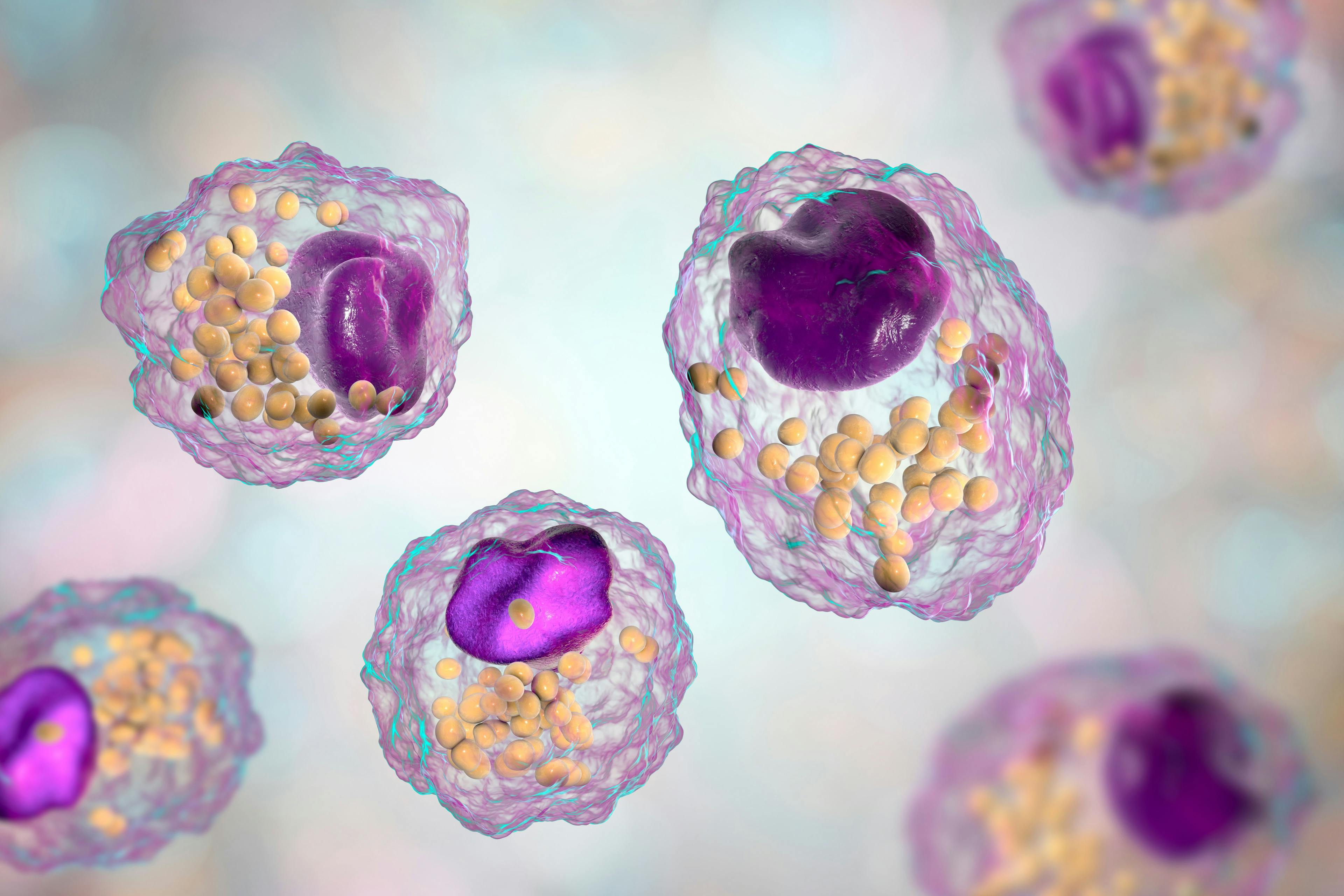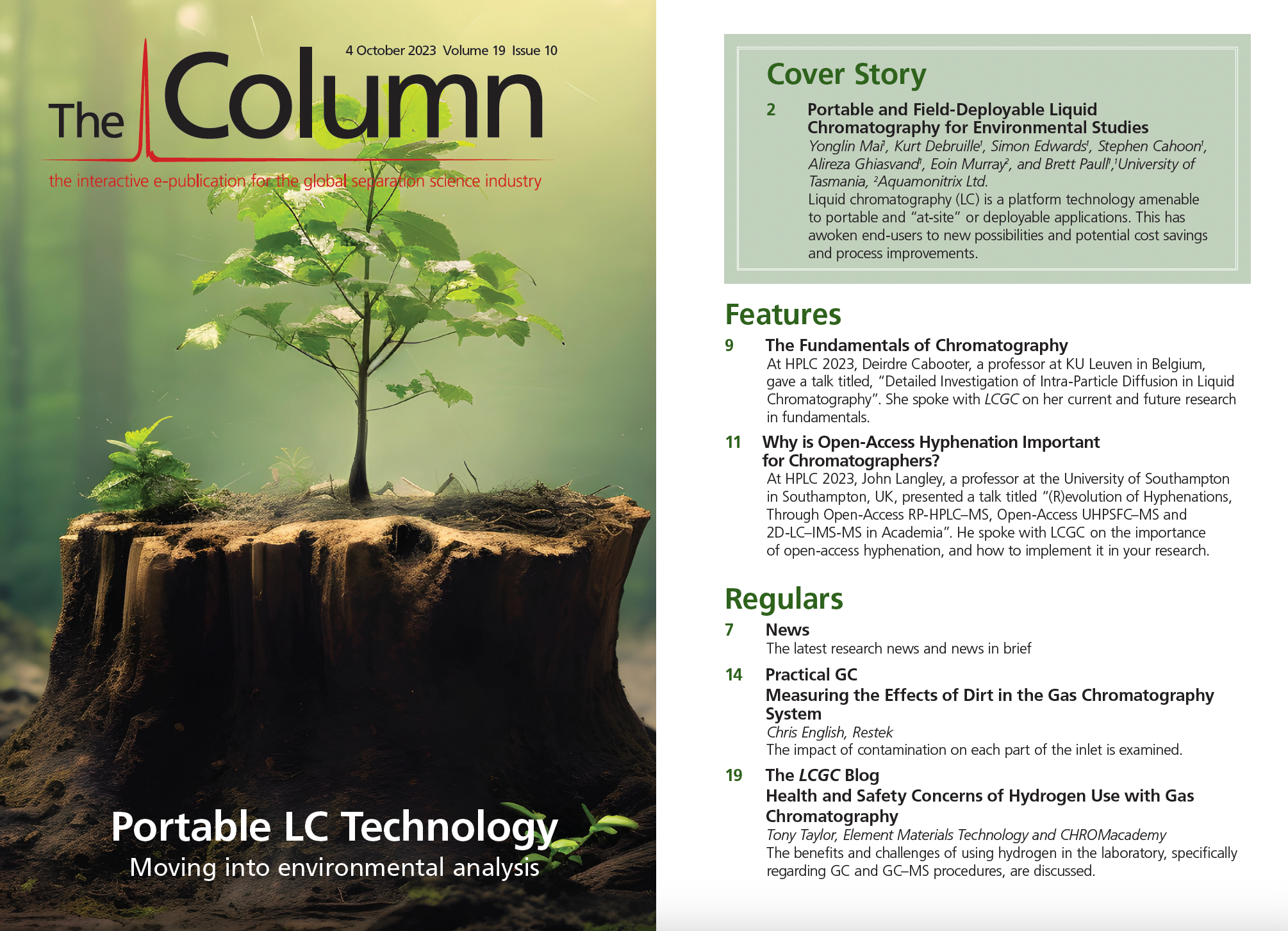Measuring the Effects of Dirt in the Gas Chromatography System
Soil extracts contain a variety of natural contaminants such as aldehydes, amides, carboxylic acids, and alkanes, along with potential environmental contaminants, including heavy oils. Nonvolatile compounds adhere to the liner walls, the wool inside of the liner, the inlet seal, and the head of the column. This article will explore the impact of contamination on each part of the inlet, including the head of the column.
In a previous “Practical GC” instalment, the components of soil and their impact on the gas chromatography (GC) system were described (1); it was found that while it would be possible to contaminate the system, a harsher sample extract was necessary—one that would accelerate peak degradation as a result of nonvolatile residue in the injection port and the head of the column. An in-house method was developed by Chris Rattray to determine column lifetime using a National Institute of Standards and Technology (NIST) Standard Reference Material (SRM) 1975 diesel particulate extract that contained polycyclic aromatic hydrocarbons (PAHs), nitro-substituted PAHs, as well as a variety of other hydrocarbons and nonvolatile residues (2). The goal was to measure column lifetime, which could then be applied to estimate the lifetime of high-throughput environmental laboratory columns. This could also be used to measure the impact of contamination on specific inlet parts as well as the column.
Split injection has the advantage of minimizing residence time of the analyte in the hot inlet, which minimizes activity. In addition, only a portion of the sample (and a portion of the contamination) reaches the head of the column, allowing the system to stay up longer before maintenance is required. Jack Cochran demonstrated an increase in activity using splitless GC settings for the analysis of endrin and dichlorodiphenyltrichloroethane (DDT) after 145 injections of used motor oil (3). The downside of split injection can be a loss of sensitivity, as the amount on-column is inevitably less. As many laboratories still use splitless, and it highlights the impact of contamination in the hot inlet, this technique was chosen for the following study.
Experimental Design
A mix was used to verify optimum performance by evaluating the peak areas of 1,6-hexanediol, 2,4-dinitrophenol, 2-ethylhexanoic acid, pentachlorophenol, dicylohexylamine, and benzidine in methylene chloride. These compounds were compared to the peak areas of neutral compounds (acenaphthalene-d10 and tridecane) in the mixture and peak area ratios were monitored. A 30 m × 0.25 mm, 0.25-µm 5-type (5% diphenyl) column was used (Restek) with the following oven programme: 50 °C starting temperature with a hold time of 4 min, followed by a 40 °C/min ramp to 340 °C, with a final hold time of 5 min. The selected liner was a single goose-neck 4 mm internal diameter (i.d.) with wool at the bottom. A 1 µL splitless injection of the 5 ppm test mix was performed using a gas chromatograph–mass spectrometer (GC–MS) system (Agilent), with a scan range of 35 to 550 amu. Once optimum performance was verified with the test mix, 50 injections of NIST SRM 1975 without dilutions were injected followed by the test mix. Injection port parts were removed one at a time and the test mix was analyzed after each part was replaced. The order in which the inlet parts were replaced was: inlet seal, wool, liner with wool, and finally cut 0.5 m of column followed by another 0.5 m of column.
Results and Discussion
The surface area of the inlet parts (as well as the column) play an important role in determining the degree of activity. After injecting the extracts, the top of the wool and the gold inlet seal were black; however, the wool represents a surface area 30 times greater than the gold inlet seal, indicating that the contribution of the inlet seal to activity in the inlet should be minimal (Figure 1). However, the gold inlet seal can contribute to DDT breakdown in the inlet when wool is not used in combination with a rapid autosampler injection (4). Figure 1 outlines the surface areas of the sample pathway for the inlet parts, where the gold seal is 1 cm2 , liner 4.4 cm2 , glass wool 30 cm2, and the column 236 cm2. The column surface area is misleading because the majority of the contamination can be found in the first 0.5 m section, which accounts for 3.9 cm2. This is the most critical part of the capillary column for focusing analytes and these compounds have the most contact time with contamination. Contamination at the head of the column can interfere with analyte focusing and can result in distorted peak shapes (Figures 2 and 3).
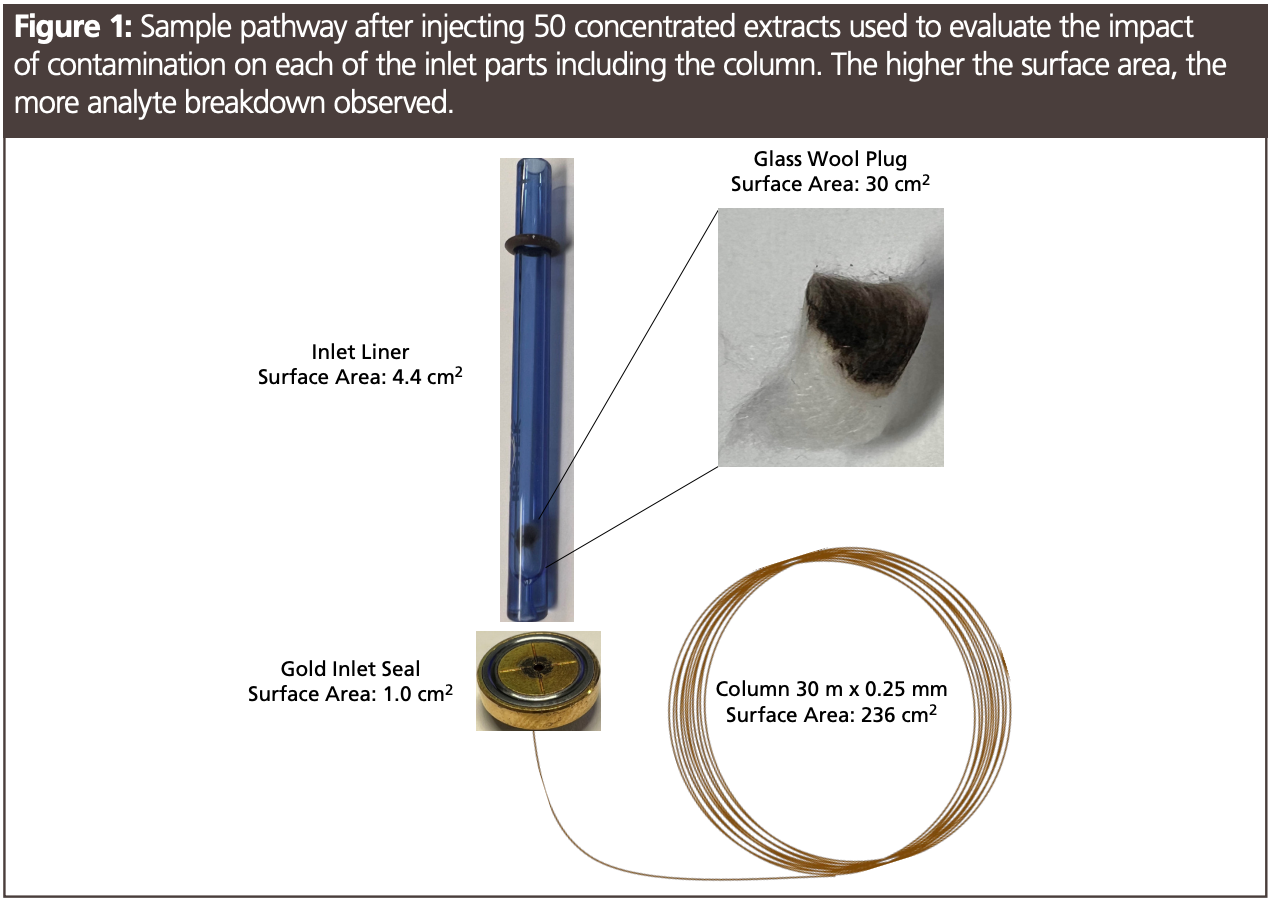

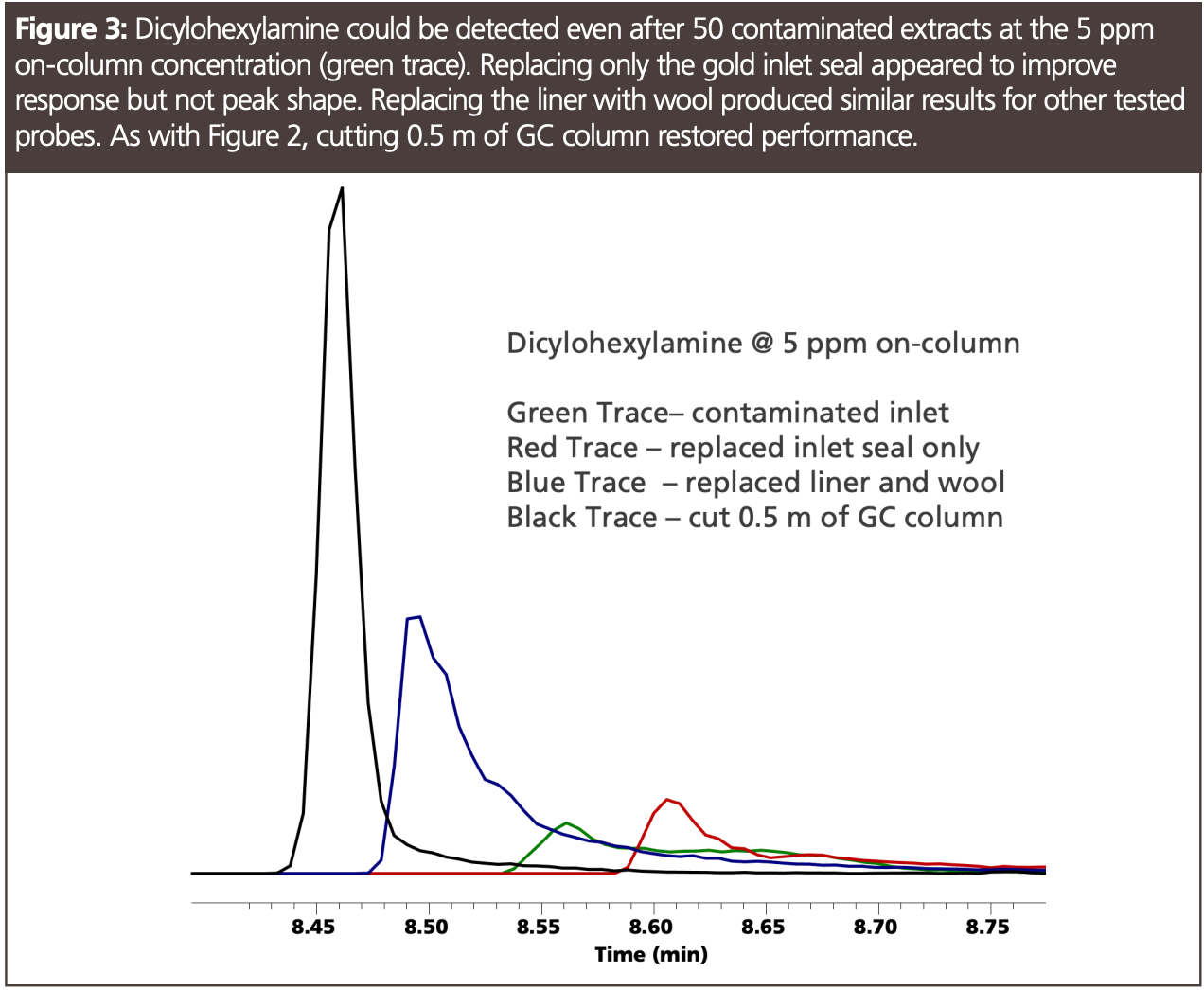
Benzidine is a biphenyl primary amine; it is basic in nature and an excellent probe for the determination of acidic contamination. After 50 injections of the extract, benzidine was not detected at the 5 ng on-column concentration. The inlet seal was first replaced and the test mix re-run, and still no measurable responses for benzidine were achieved. Figure 2 illustrates how replacing the wool (red trace) resulted in some response. This was followed by replacing the liner (blue trace), which offered a small increase in response. The interaction between the analyte and the contamination at the head of the column accounts for the distorted peak shape shown in both the blue trace and the red trace. After cutting 0.5 m of column, the peak shape and areas were restored to the conditions observed before the 50 injections of extracts.
Dicylcohexlamine is a secondary amine; more stable than benzidine, it is also a good indicator of acidic activity in the inlet and on the column. It was detected following the analysis of the extracts—although the compound was smeared over an area of 0.27 min (Figure 3). Replacing the inlet seal (red trace) increased the response, and replacing the liner and wool enhanced the response but did not change the overall peak shape. As with benzidine, peak shape was only restored when the column was trimmed (black trace).
Several of the other probes provided interesting results; for example, 1,6-hexanediol, a compound with two hydroxy-groups, had a threefold decrease in response following the extracts, but there was no observable differences with inlet maintenance. After cutting the column, the response was restored. 2,4-Dinitrophenol and pentachlorophenol are notoriously unpredictable compounds, and injection port maintenance and column trimming did not completely restore performance. A second trimming of the column also did not increase the area response. 2-Ethylhexanoic acid remained mostly unchanged throughout the study.
Conclusion
Contamination at the head of the column interferes with analyte focusing and results in distorted peak shapes. The first 0.5 m of column had the biggest impact on peak shape and response. For inlet maintenance, replacing the wool showed the greatest improvement in peak areas, but it did not improve peak shapes. Replacing the wool also did not restore compound responses. Cutting the column following injection port maintenance for most of the compounds restored performance. Aside from that, the surface area of the inlet parts plays a role in determining the degree of activity and the effect on peak shapes, but the impact was not as big as initially expected.
Acknowledgements
Jaap de Zeeuw and Erica Pack for technical advice and review.
References
(1) English, C. Do Soil Samples Contaminate the Gas Chromatography System? The Column 2023, 19 (6), 12–16.
(2) English, C.; Hilliard, C.; Rattray, C.; et al. Development of a Semi-Volatile Column Optimized for the Analysis of Hazardous Waste. Environmental Measurement Symposium, Minneapolis, Minnesota, USA. July 31, 2023.
(3) Cochran, J. Split Injection GC: The Benefits of “Shoot-and-Dilute” GC. The Column 2015, 11 (21), 5–10.
(4) Cochran, J. A Fast Autosampler Injection Can Promote DDT Degradation, Blog. https://www.restek.com/chromablography/a-fast-autosampler-injection-can-promote-ddt-degradation (accessed 2023-09-11)
About the Author
Chris English has managed a team of chemists in Restek’s innovations laboratory since 2004. Before taking the reins of the laboratory, he spent seven years as an environmental chemist and was critical to the development of Restek’s current line of volatile GC columns. Chris holds a B.S. in environmental science from Saint Michael’s College, USA.
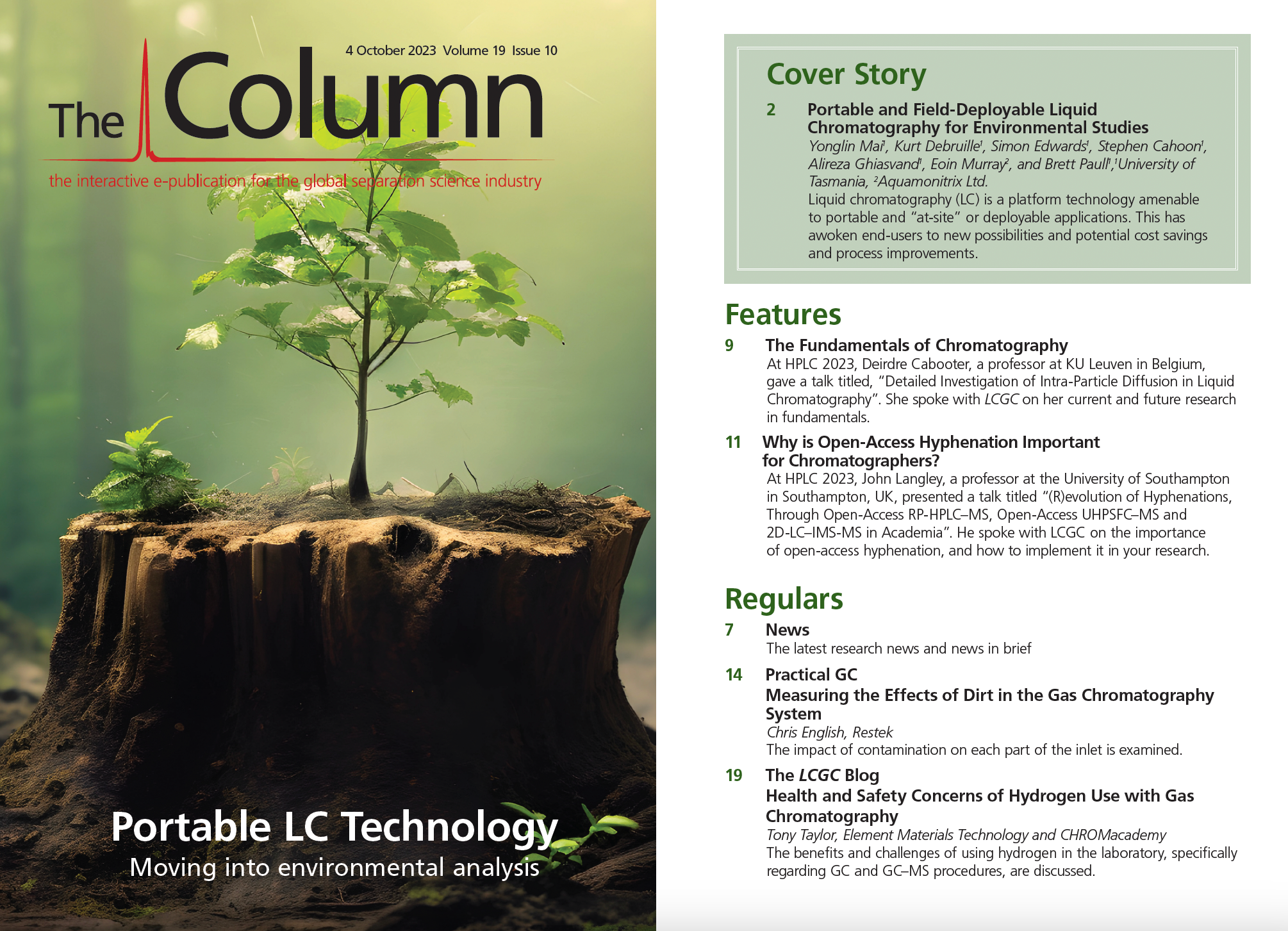
Detecting Hyper-Fast Chromatographic Peaks Using Ion Mobility Spectrometry
May 6th 2025Ion mobility spectrometers can detect trace compounds quickly, though they can face various issues with detecting certain peaks. University of Hannover scientists created a new system for resolving hyper-fast gas chromatography (GC) peaks.
Altering Capillary Gas Chromatography Systems Using Silicon Pneumatic Microvalves
May 5th 2025Many multi-column gas chromatography systems use two-position multi-port switching valves, which can suffer from delays in valve switching. Shimadzu researchers aimed to create a new sampling and switching module for these systems.
New Method Explored for the Detection of CECs in Crops Irrigated with Contaminated Water
April 30th 2025This new study presents a validated QuEChERS–LC-MS/MS method for detecting eight persistent, mobile, and toxic substances in escarole, tomatoes, and tomato leaves irrigated with contaminated water.
University of Tasmania Researchers Explore Haloacetic Acid Determiniation in Water with capLC–MS
April 29th 2025Haloacetic acid detection has become important when analyzing drinking and swimming pool water. University of Tasmania researchers have begun applying capillary liquid chromatography as a means of detecting these substances.

.png&w=3840&q=75)

.png&w=3840&q=75)



.png&w=3840&q=75)



.png&w=3840&q=75)

